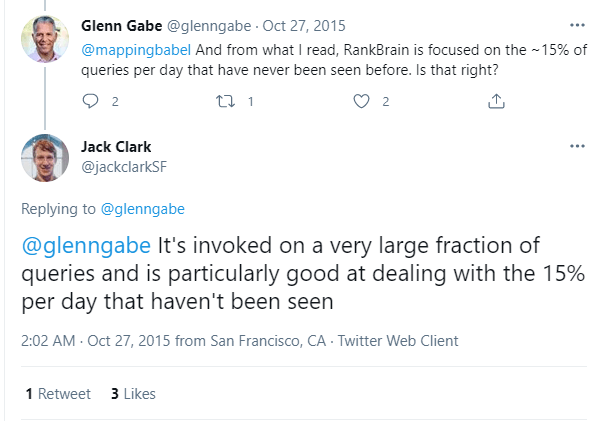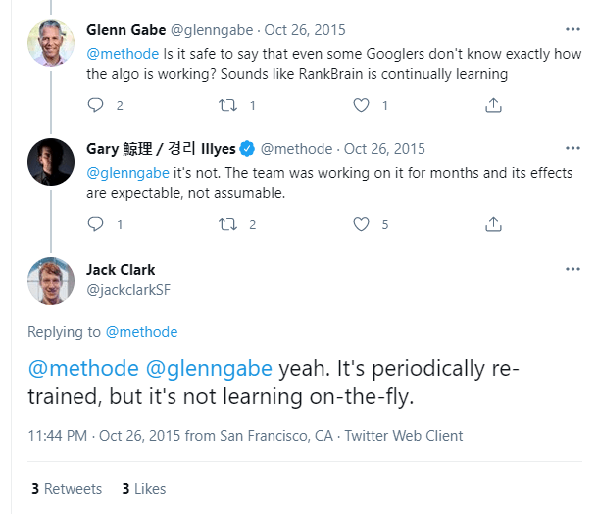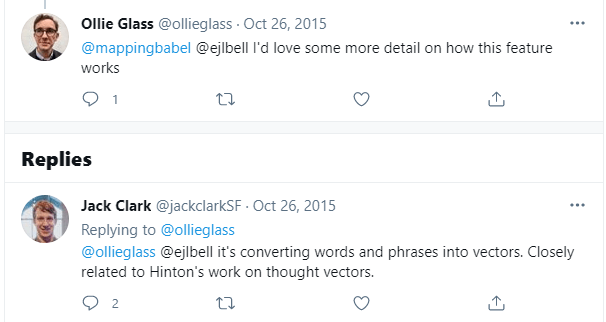Rankbrain Algorithm is the algorithm developed by Google with the aim of better understanding the search intent behind queries and interpreting queries much better with the support of artificial intelligence, machine learning. With the Rankbrain algorithm, which is stated as the 3rd most important algorithm used by Google and officially announced on October 26, 2015, Google has started to understand and interpret queries much better, especially queries that it previously had difficulty answering.
The most important difference that distinguishes the Rankbrain algorithm from other Google algorithms is that the algorithm can improve itself with the support of deep learning, artificial intelligence and minimal intervention of Google engineers. Although the AI-supported algorithm improves itself with machine learning, it still needs periodic improvements from Google engineers.
When the Rankbrain algorithm sees a query that it has not encountered before or when it displays a keyword (entity) or phrase that it has not encountered before in any query, it predicts the keywords that can replace the keyword it cannot define in the relevant query using word vectors and interprets the query. After determining the words and phrases that can replace the keywords it cannot identify, it reinterprets the query accordingly and filters the search results accordingly.
With this process performed on unknown keywords, phrases and queries, it is ensured that the search purpose behind the queries and the general meaning of the query are solved much more successfully with the support of artificial intelligence.
Search queries performed on Google are grouped into word vectors (numbers that express the meaning of words) according to their language compatibility and meaning. The Rankbrain algorithm groups the words that have linguistic (linguistic) semantic integrity within themselves, which are synonyms and close meanings with each other, as a match (cluster) within itself.
These word vectors (Word2vec) and word matches are used to better interpret any query performed on Google, to better analyze the search purpose behind the query, and most importantly, to analyze a word or expression whose meaning is unknown by interpreting it with a different word or expression.
Different Google algorithms related to Rankbrain;
- Google Hummingbird
What is the Purpose of the Google Rankbrain Algorithm?
Google responds to billions of queries every day, and approximately 15% of the queries are "different" queries that the Google algorithm has not encountered before, which are unique and outside of routine queries. These queries are difficult to answer in a routine way because they are encountered by Google for the first time and especially because a significant portion of them are in the form of natural language queries. The fact that approximately 15% of Google's billions of queries could not be understood and answered routinely was a significant challenge before Rankbrain.
Within this challenge and purpose, Google developed the Rankbrain algorithm with the aim of analyzing queries that Google has not encountered before much better and organizing search results accordingly, with the support of artificial intelligence, with minimal need for external intervention and self-learning.
What is the Importance of the Rankbrain Algorithm?
Implemented in early 2015 and officially announced in October 2015, Rankbrain was stated by Google as the 3rd most important ranking factor of the search system (core). One of the most important factors determining the importance of the Rankbrain algorithm in the Google search system is its ability to improve itself with minimal intervention from Google engineers thanks to deep learning.
One of the most critical factors that increase the importance of Rankbrain in the Google search system is that it learns the queries that Google has not encountered before and has difficulty in presenting healthy search results unlike routine, especially by using historical search data with deep learning, and makes the search results much more compatible with the users' search intent.
Greg Corrado, Google's senior researcher and engineer, said the following about Rankbrain; Rankbrain is one of the hundreds of signals that Google uses to determine which websites will be ranked on the search results page. However, among these hundreds of signals, Rankbrain has become the 3rd most important signal that has been effective in determining the ranking on the search results page for a search query since its release.
Source: https://searchengineland.com/meet-rankbrain-google-search-results-234386 - Danny Sullivan
Another factor that makes Rankbrain the 3rd most important factor among Google algorithms (ranking factors) is the long-tail queries that have increased in parallel with Google's ability to understand queries and match content with queries according to their relevance. In parallel with the increasing long-tail queries, the frequency and effectiveness of the Rankbrain algorithm has increased and the importance of Rankbrain in the algorithm has increased.
How Does the Rankbrain Algorithm Work?
Rankbrain deep learning as an artificial intelligence-supported algorithm, tries to decide how to better create search result pages related to any query by looking at historical search data (historical data). While determining the search results related to the query, it expands and interprets the query by looking at many different signals and organizes the search results accordingly.
As explained by Garry Illyes in the video below, Rankbrain shows a very successful performance with its current working system, especially in answering queries that have not been routinely answered by Google before and have not been encountered before.
In particular, Natural Language Queries, which are the most challenging for Google among the queries that have not been routinely answered in a healthy, targeted manner and have not been encountered before, have started to be analyzed and interpreted much better with Rankbrain.
Typically, in routine queries on Google, Google collects query data, determines search results and stores the results as historical data. When a query is performed on Google that the algorithm has not encountered before, or when queries similar to everyday spoken language, which we call natural language queries, are entered in a way that classical algorithms cannot easily understand, since the data related to such queries is not routinely available, Rankbrain comes into play for such queries and predicts and interprets the query using the data obtained from queries that have been used in a similar style in the past and determines the search results accordingly.
If long tail and natural language queries have not been encountered by Google before, Rankbrain predicts the words that will correspond to the words and expressions in the query by using Word vectors used to group the words used in search queries and interprets the query accordingly. The data used in these groupings is created by utilizing data from queries that have been created in a similar style in the past.
Rankbrain divides the queries into keywords and entities and groups words and word clusters that may be compatible with the query according to their linguistic structure and meaning similarities and tries to predict the query. In the process of semantic sorting and matching of words (entities) with each other, word vectors (word2vec) are used to help the algorithm make sense of the meaning of words. At this point, if you use a phrase or word that is not frequently used in a query and the meaning of the query becomes blurred for Google, Google tries to guess the relevant keyword using its alternative by using the Rankbrain algorithm and generates the search results of the query accordingly.
Rankbrain is not directly related to different factors of the search system such as local search, links, spam analysis. It is only directly related to the improvement of search results for queries, and a much more successful understanding and interpretation of ambiguous queries.
Rankbrain performs a check on all queries as part of the classic core algorithm and checks whether the search results of any query have already been successfully generated. For any query, if the content in the search results returned in response to the query is incompatible with the relevance of the query, Rankbrain recalculates the query and reorganizes the search results. It is possible to say that Rankbrain plays an active role in many queries today, especially because it is successful in long-tail and natural language queries due to its function.
Rankbrain is Used in a Significant Part of Queries

As mentioned above, Rankbrain, which gives very successful results in approximately 15% of the total queries that Google encountered for the first time, is also used in queries other than 15% of the total queries, especially due to its structure and function.
Contrary to popular belief, the Rankbrain algorithm is actively used in many queries performed on Google, in addition to natural language queries and queries encountered for the first time.
Rankbrain is Periodically Retrained

Although Rankbrain performs learning for the operations it performs with deep learning, it was said on Twitter by Jack Clark and Garry Illyes that the deep learning it provides within itself is not continuous and does not perform the learning process instantly.
Although it is not continuous for the Rankbrain algorithm, relearning and reprogramming processes are provided by Google engineers related to new queries and search structures it encounters. The Rankbrain algorithm is periodically reorganized (trained).
Knowledge Graph, Hummingbird and Rankbrain
Google's Knowledge Graph, announced in 2012, and the Hummingbird algorithm, announced a year later in 2013, were the first steps in Google's semantic search mission, announcing the algorithm's transition from strings to entities and (vectors).
With the Hummingbird algorithm, Google started to understand and interpret the entities, keywords and the meaning of a sentence much more successfully (expanding queries), and with the Knowledge Graph, it started to record the facts and attributes (links) of any entity in the database and to make sense of the queries and the statements in the query much more successfully.
The Hummingbird algorithm and the Hummingbird algorithm have expanded the meaning of queries and started to interpret them better, and the Knowledge Graph and entity-based semantic searches were the developments that formed the basis of the queries we successfully perform today.
At this point, the capabilities gained by the Knowledge Graph and basically the core algorithm with the Hummingbird algorithm have become much more automated with Rankbrain, and the artificial intelligence-supported algorithm has become able to learn, answer and interpret much more complex queries.
Rankbrain and Word Vectors (Word2Vec)

According to Jack Clark, Word Vectors, which Google uses in NLP (Natural Language Processing), that is, in its work on natural language perception, are also used in the Rankbrain algorithm, which is developed and used by computers, that is, the algorithm, to better understand the meaning of the word and the relationships between words.
In order to better understand the meaning of the words in any web document and the sentences in the document, Word vectors are used to determine the meanings of words and the relationships between words with similar meanings and to save them in the database. Likewise, in queries performed on Google, words are divided into word vectors and the meaning of the query and words with similar meanings that can replace the words used in the query are saved as "distributed representation".
Rankbrain uses vectors to look at the relationship and semantic integrity of words and phrases in a query with words and phrases used in different queries using historical data and learns the linguistic and semantic relationships between words.